Analyzing Leadership Effectiveness in Contemporary Organizations
VerifiedAdded on 2023/02/01
|6
|1633
|55
Essay
AI Summary
This essay provides a comprehensive analysis of leadership in contemporary organizations, addressing key concepts such as the Pygmalion effect, challenges to achieving leadership goals, and the applicability of transformational leadership. It discusses the importance of core leadership values like integrity, courage, and humility, and offers strategies for resolving conflicts within organizations. The essay also examines how leaders can integrate individual efforts with organizational objectives to enhance overall performance. Desklib offers this essay as part of its extensive library of solved assignments and study resources for students.
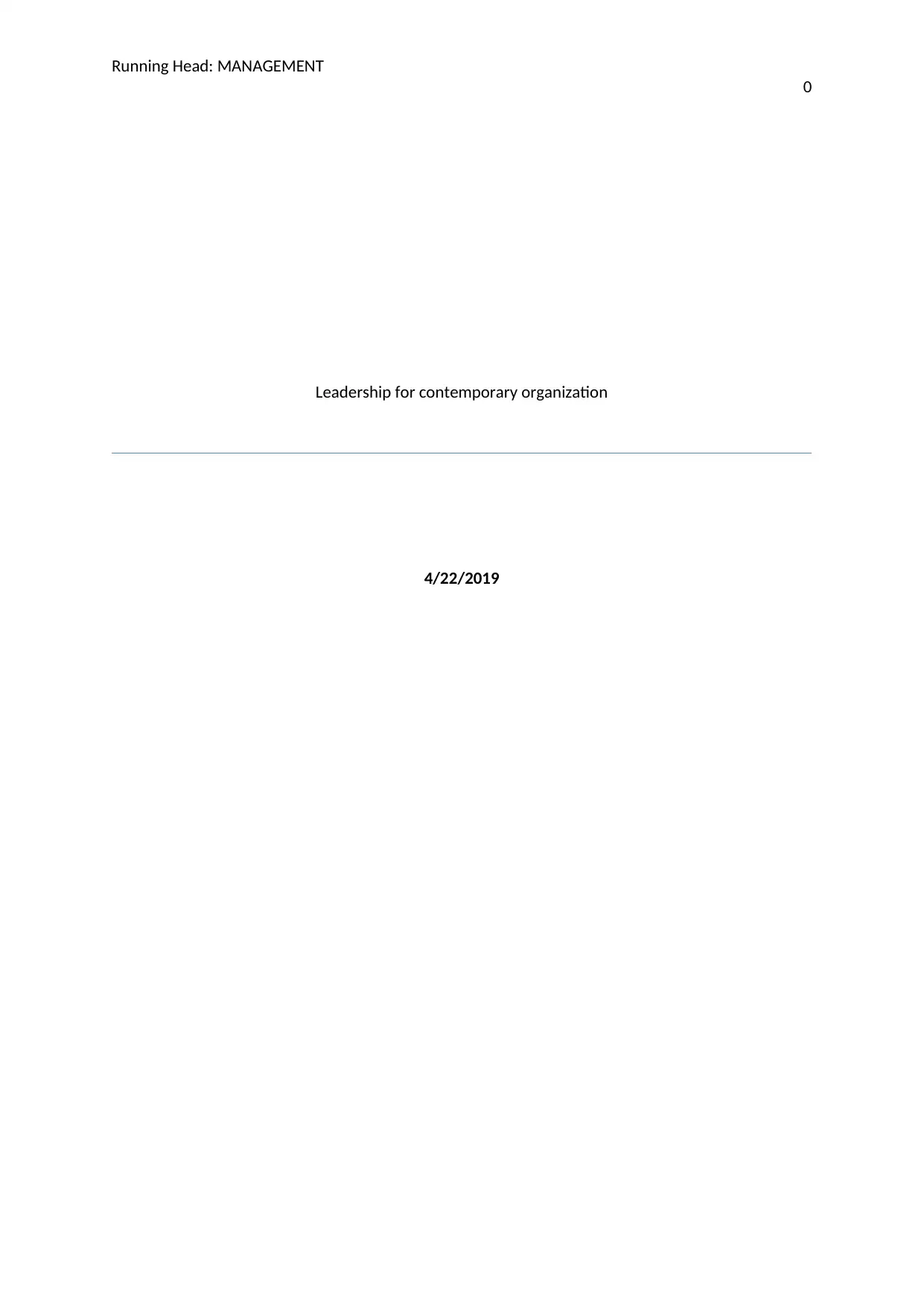
Running Head: MANAGEMENT
0
Leadership for contemporary organization
4/22/2019
0
Leadership for contemporary organization
4/22/2019
Paraphrase This Document
Need a fresh take? Get an instant paraphrase of this document with our AI Paraphraser
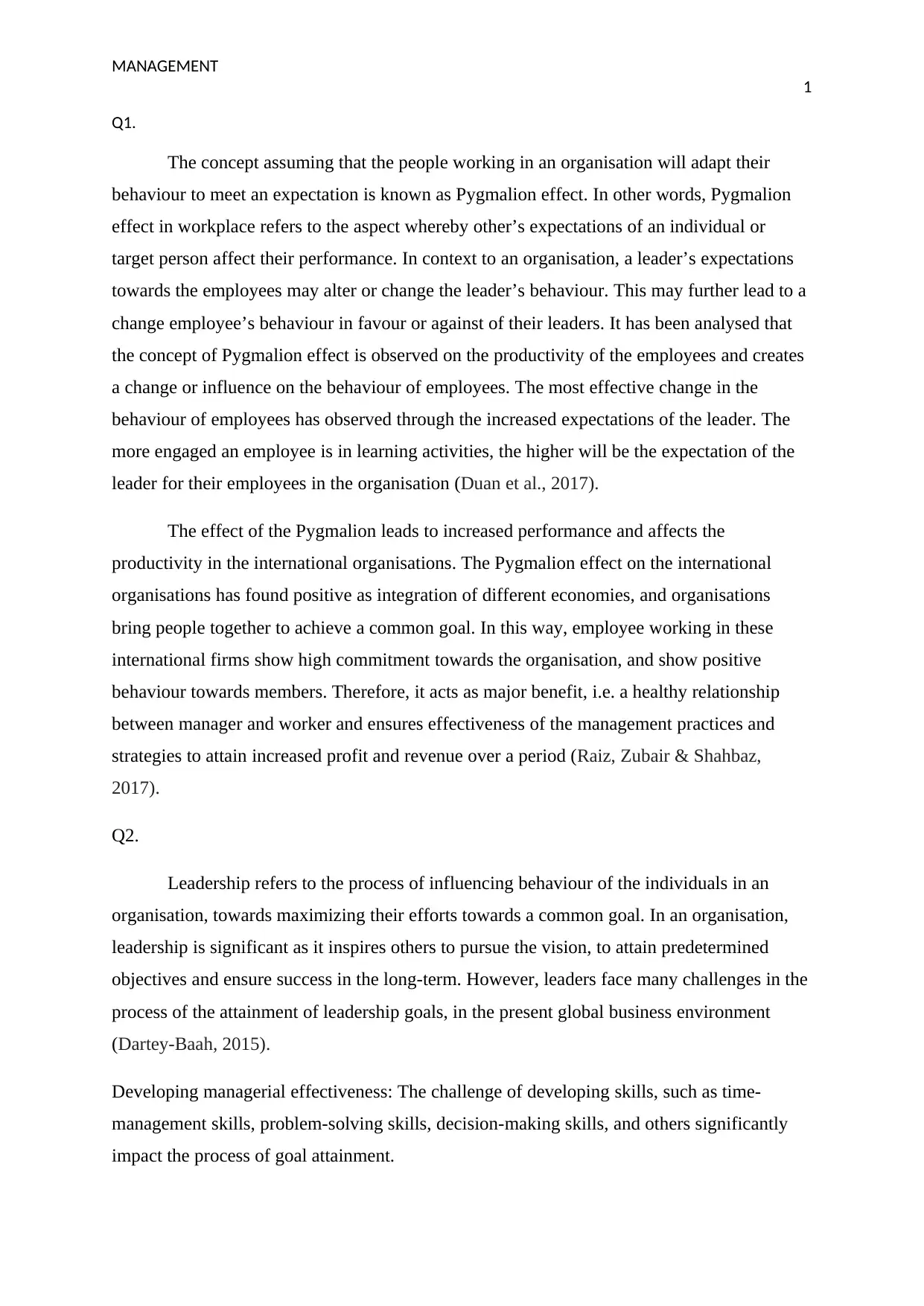
MANAGEMENT
1
Q1.
The concept assuming that the people working in an organisation will adapt their
behaviour to meet an expectation is known as Pygmalion effect. In other words, Pygmalion
effect in workplace refers to the aspect whereby other’s expectations of an individual or
target person affect their performance. In context to an organisation, a leader’s expectations
towards the employees may alter or change the leader’s behaviour. This may further lead to a
change employee’s behaviour in favour or against of their leaders. It has been analysed that
the concept of Pygmalion effect is observed on the productivity of the employees and creates
a change or influence on the behaviour of employees. The most effective change in the
behaviour of employees has observed through the increased expectations of the leader. The
more engaged an employee is in learning activities, the higher will be the expectation of the
leader for their employees in the organisation (Duan et al., 2017).
The effect of the Pygmalion leads to increased performance and affects the
productivity in the international organisations. The Pygmalion effect on the international
organisations has found positive as integration of different economies, and organisations
bring people together to achieve a common goal. In this way, employee working in these
international firms show high commitment towards the organisation, and show positive
behaviour towards members. Therefore, it acts as major benefit, i.e. a healthy relationship
between manager and worker and ensures effectiveness of the management practices and
strategies to attain increased profit and revenue over a period (Raiz, Zubair & Shahbaz,
2017).
Q2.
Leadership refers to the process of influencing behaviour of the individuals in an
organisation, towards maximizing their efforts towards a common goal. In an organisation,
leadership is significant as it inspires others to pursue the vision, to attain predetermined
objectives and ensure success in the long-term. However, leaders face many challenges in the
process of the attainment of leadership goals, in the present global business environment
(Dartey-Baah, 2015).
Developing managerial effectiveness: The challenge of developing skills, such as time-
management skills, problem-solving skills, decision-making skills, and others significantly
impact the process of goal attainment.
1
Q1.
The concept assuming that the people working in an organisation will adapt their
behaviour to meet an expectation is known as Pygmalion effect. In other words, Pygmalion
effect in workplace refers to the aspect whereby other’s expectations of an individual or
target person affect their performance. In context to an organisation, a leader’s expectations
towards the employees may alter or change the leader’s behaviour. This may further lead to a
change employee’s behaviour in favour or against of their leaders. It has been analysed that
the concept of Pygmalion effect is observed on the productivity of the employees and creates
a change or influence on the behaviour of employees. The most effective change in the
behaviour of employees has observed through the increased expectations of the leader. The
more engaged an employee is in learning activities, the higher will be the expectation of the
leader for their employees in the organisation (Duan et al., 2017).
The effect of the Pygmalion leads to increased performance and affects the
productivity in the international organisations. The Pygmalion effect on the international
organisations has found positive as integration of different economies, and organisations
bring people together to achieve a common goal. In this way, employee working in these
international firms show high commitment towards the organisation, and show positive
behaviour towards members. Therefore, it acts as major benefit, i.e. a healthy relationship
between manager and worker and ensures effectiveness of the management practices and
strategies to attain increased profit and revenue over a period (Raiz, Zubair & Shahbaz,
2017).
Q2.
Leadership refers to the process of influencing behaviour of the individuals in an
organisation, towards maximizing their efforts towards a common goal. In an organisation,
leadership is significant as it inspires others to pursue the vision, to attain predetermined
objectives and ensure success in the long-term. However, leaders face many challenges in the
process of the attainment of leadership goals, in the present global business environment
(Dartey-Baah, 2015).
Developing managerial effectiveness: The challenge of developing skills, such as time-
management skills, problem-solving skills, decision-making skills, and others significantly
impact the process of goal attainment.
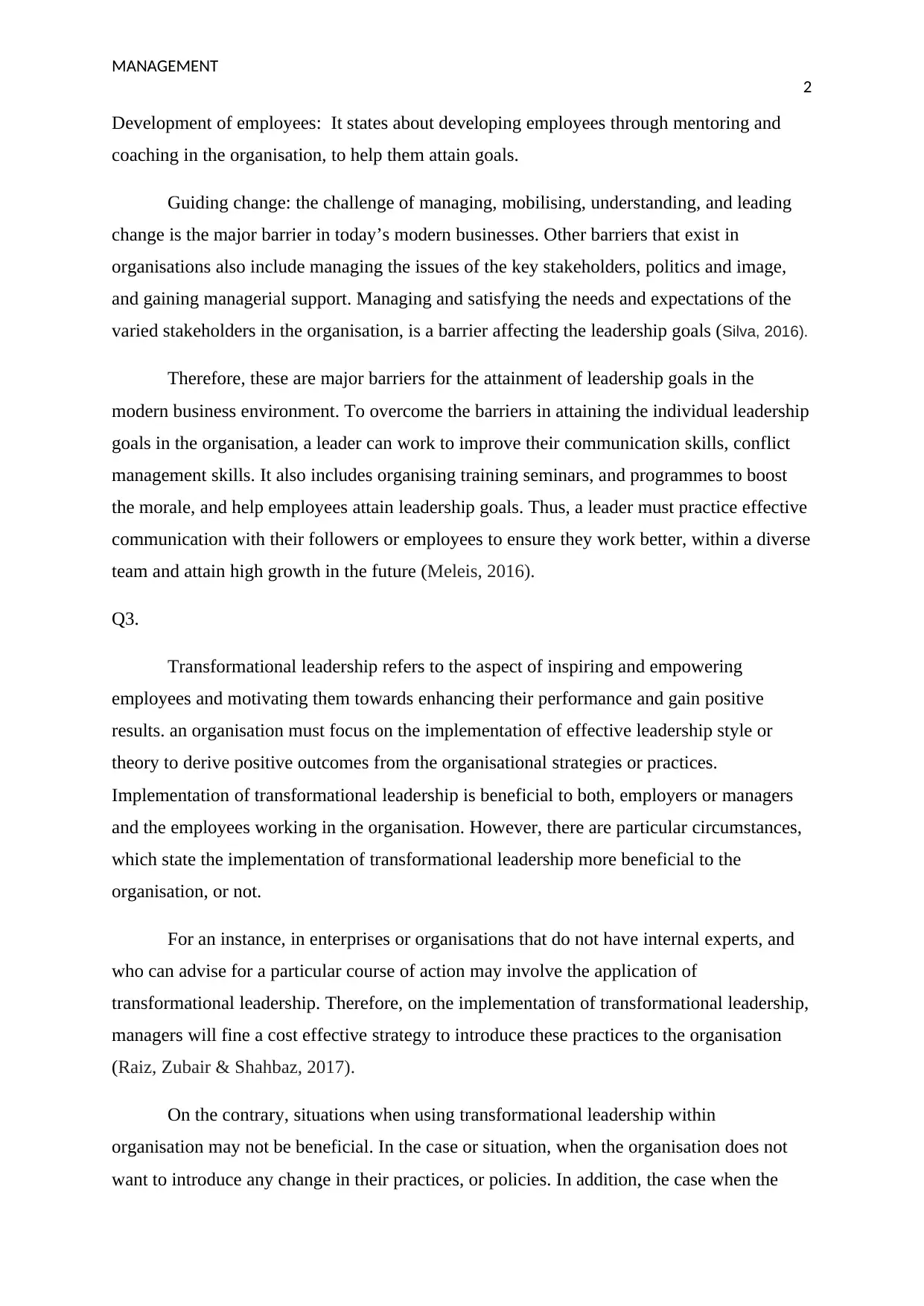
MANAGEMENT
2
Development of employees: It states about developing employees through mentoring and
coaching in the organisation, to help them attain goals.
Guiding change: the challenge of managing, mobilising, understanding, and leading
change is the major barrier in today’s modern businesses. Other barriers that exist in
organisations also include managing the issues of the key stakeholders, politics and image,
and gaining managerial support. Managing and satisfying the needs and expectations of the
varied stakeholders in the organisation, is a barrier affecting the leadership goals (Silva, 2016).
Therefore, these are major barriers for the attainment of leadership goals in the
modern business environment. To overcome the barriers in attaining the individual leadership
goals in the organisation, a leader can work to improve their communication skills, conflict
management skills. It also includes organising training seminars, and programmes to boost
the morale, and help employees attain leadership goals. Thus, a leader must practice effective
communication with their followers or employees to ensure they work better, within a diverse
team and attain high growth in the future (Meleis, 2016).
Q3.
Transformational leadership refers to the aspect of inspiring and empowering
employees and motivating them towards enhancing their performance and gain positive
results. an organisation must focus on the implementation of effective leadership style or
theory to derive positive outcomes from the organisational strategies or practices.
Implementation of transformational leadership is beneficial to both, employers or managers
and the employees working in the organisation. However, there are particular circumstances,
which state the implementation of transformational leadership more beneficial to the
organisation, or not.
For an instance, in enterprises or organisations that do not have internal experts, and
who can advise for a particular course of action may involve the application of
transformational leadership. Therefore, on the implementation of transformational leadership,
managers will fine a cost effective strategy to introduce these practices to the organisation
(Raiz, Zubair & Shahbaz, 2017).
On the contrary, situations when using transformational leadership within
organisation may not be beneficial. In the case or situation, when the organisation does not
want to introduce any change in their practices, or policies. In addition, the case when the
2
Development of employees: It states about developing employees through mentoring and
coaching in the organisation, to help them attain goals.
Guiding change: the challenge of managing, mobilising, understanding, and leading
change is the major barrier in today’s modern businesses. Other barriers that exist in
organisations also include managing the issues of the key stakeholders, politics and image,
and gaining managerial support. Managing and satisfying the needs and expectations of the
varied stakeholders in the organisation, is a barrier affecting the leadership goals (Silva, 2016).
Therefore, these are major barriers for the attainment of leadership goals in the
modern business environment. To overcome the barriers in attaining the individual leadership
goals in the organisation, a leader can work to improve their communication skills, conflict
management skills. It also includes organising training seminars, and programmes to boost
the morale, and help employees attain leadership goals. Thus, a leader must practice effective
communication with their followers or employees to ensure they work better, within a diverse
team and attain high growth in the future (Meleis, 2016).
Q3.
Transformational leadership refers to the aspect of inspiring and empowering
employees and motivating them towards enhancing their performance and gain positive
results. an organisation must focus on the implementation of effective leadership style or
theory to derive positive outcomes from the organisational strategies or practices.
Implementation of transformational leadership is beneficial to both, employers or managers
and the employees working in the organisation. However, there are particular circumstances,
which state the implementation of transformational leadership more beneficial to the
organisation, or not.
For an instance, in enterprises or organisations that do not have internal experts, and
who can advise for a particular course of action may involve the application of
transformational leadership. Therefore, on the implementation of transformational leadership,
managers will fine a cost effective strategy to introduce these practices to the organisation
(Raiz, Zubair & Shahbaz, 2017).
On the contrary, situations when using transformational leadership within
organisation may not be beneficial. In the case or situation, when the organisation does not
want to introduce any change in their practices, or policies. In addition, the case when the
⊘ This is a preview!⊘
Do you want full access?
Subscribe today to unlock all pages.

Trusted by 1+ million students worldwide
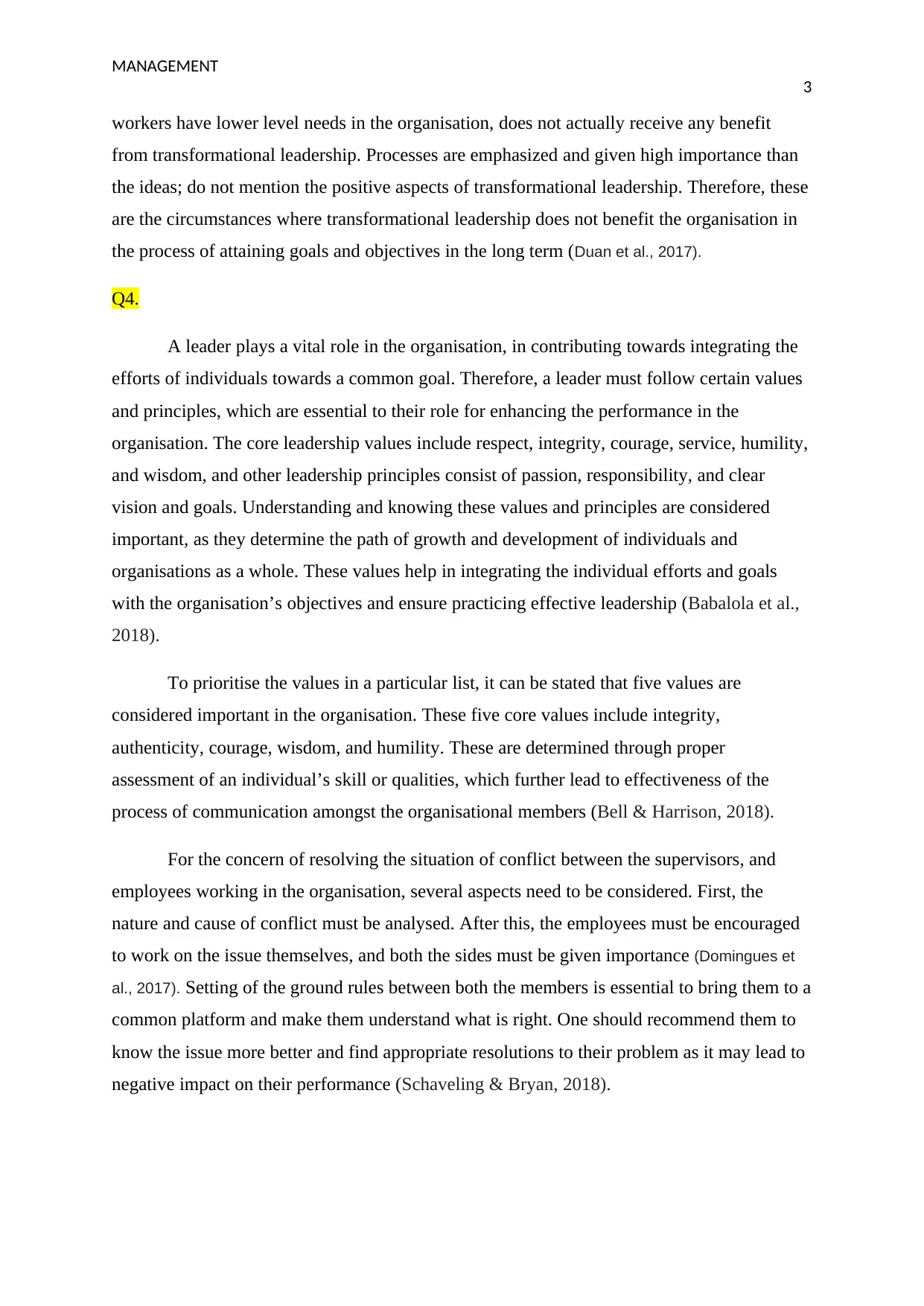
MANAGEMENT
3
workers have lower level needs in the organisation, does not actually receive any benefit
from transformational leadership. Processes are emphasized and given high importance than
the ideas; do not mention the positive aspects of transformational leadership. Therefore, these
are the circumstances where transformational leadership does not benefit the organisation in
the process of attaining goals and objectives in the long term (Duan et al., 2017).
Q4.
A leader plays a vital role in the organisation, in contributing towards integrating the
efforts of individuals towards a common goal. Therefore, a leader must follow certain values
and principles, which are essential to their role for enhancing the performance in the
organisation. The core leadership values include respect, integrity, courage, service, humility,
and wisdom, and other leadership principles consist of passion, responsibility, and clear
vision and goals. Understanding and knowing these values and principles are considered
important, as they determine the path of growth and development of individuals and
organisations as a whole. These values help in integrating the individual efforts and goals
with the organisation’s objectives and ensure practicing effective leadership (Babalola et al.,
2018).
To prioritise the values in a particular list, it can be stated that five values are
considered important in the organisation. These five core values include integrity,
authenticity, courage, wisdom, and humility. These are determined through proper
assessment of an individual’s skill or qualities, which further lead to effectiveness of the
process of communication amongst the organisational members (Bell & Harrison, 2018).
For the concern of resolving the situation of conflict between the supervisors, and
employees working in the organisation, several aspects need to be considered. First, the
nature and cause of conflict must be analysed. After this, the employees must be encouraged
to work on the issue themselves, and both the sides must be given importance (Domingues et
al., 2017). Setting of the ground rules between both the members is essential to bring them to a
common platform and make them understand what is right. One should recommend them to
know the issue more better and find appropriate resolutions to their problem as it may lead to
negative impact on their performance (Schaveling & Bryan, 2018).
3
workers have lower level needs in the organisation, does not actually receive any benefit
from transformational leadership. Processes are emphasized and given high importance than
the ideas; do not mention the positive aspects of transformational leadership. Therefore, these
are the circumstances where transformational leadership does not benefit the organisation in
the process of attaining goals and objectives in the long term (Duan et al., 2017).
Q4.
A leader plays a vital role in the organisation, in contributing towards integrating the
efforts of individuals towards a common goal. Therefore, a leader must follow certain values
and principles, which are essential to their role for enhancing the performance in the
organisation. The core leadership values include respect, integrity, courage, service, humility,
and wisdom, and other leadership principles consist of passion, responsibility, and clear
vision and goals. Understanding and knowing these values and principles are considered
important, as they determine the path of growth and development of individuals and
organisations as a whole. These values help in integrating the individual efforts and goals
with the organisation’s objectives and ensure practicing effective leadership (Babalola et al.,
2018).
To prioritise the values in a particular list, it can be stated that five values are
considered important in the organisation. These five core values include integrity,
authenticity, courage, wisdom, and humility. These are determined through proper
assessment of an individual’s skill or qualities, which further lead to effectiveness of the
process of communication amongst the organisational members (Bell & Harrison, 2018).
For the concern of resolving the situation of conflict between the supervisors, and
employees working in the organisation, several aspects need to be considered. First, the
nature and cause of conflict must be analysed. After this, the employees must be encouraged
to work on the issue themselves, and both the sides must be given importance (Domingues et
al., 2017). Setting of the ground rules between both the members is essential to bring them to a
common platform and make them understand what is right. One should recommend them to
know the issue more better and find appropriate resolutions to their problem as it may lead to
negative impact on their performance (Schaveling & Bryan, 2018).
Paraphrase This Document
Need a fresh take? Get an instant paraphrase of this document with our AI Paraphraser

MANAGEMENT
4
4
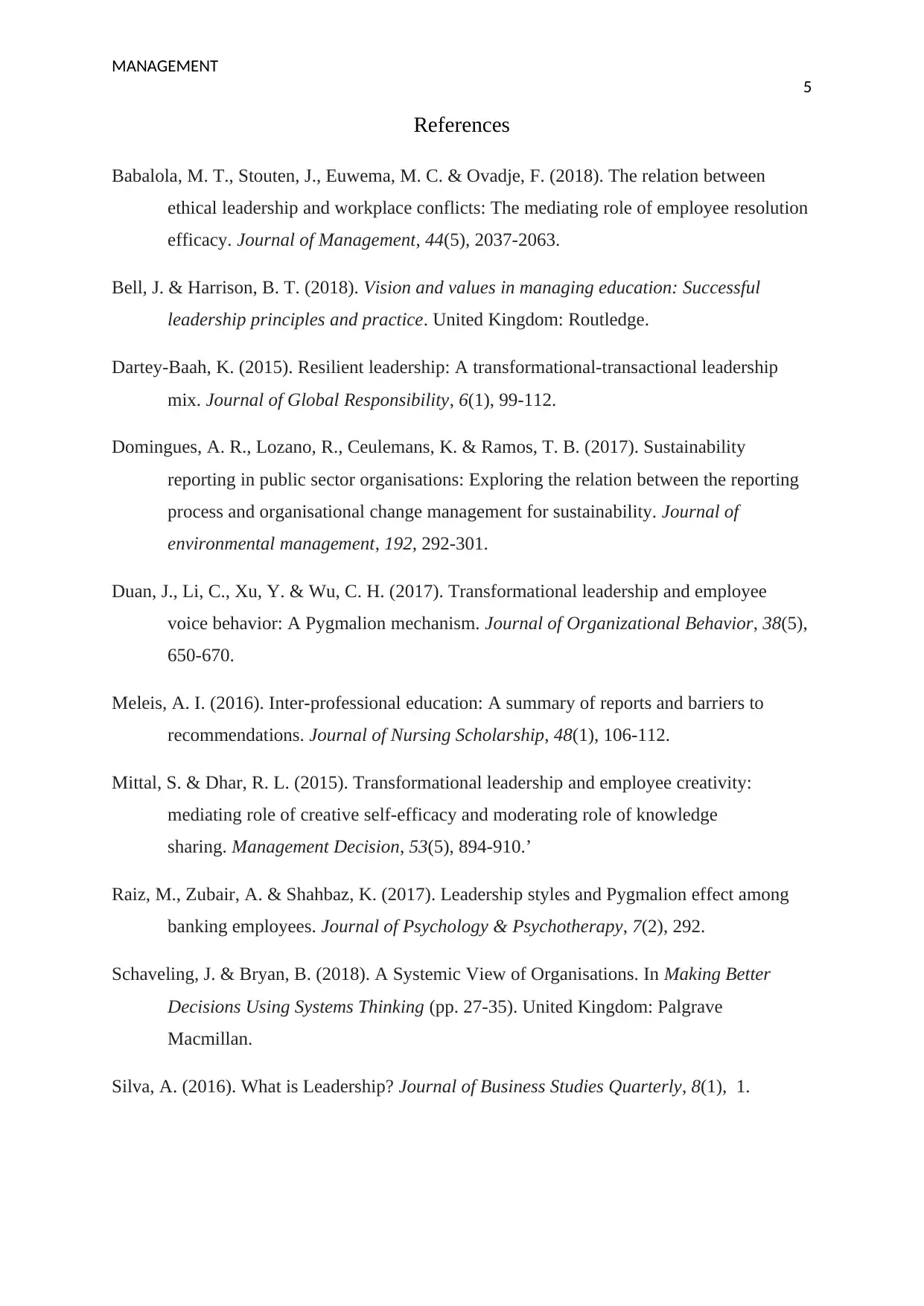
MANAGEMENT
5
References
Babalola, M. T., Stouten, J., Euwema, M. C. & Ovadje, F. (2018). The relation between
ethical leadership and workplace conflicts: The mediating role of employee resolution
efficacy. Journal of Management, 44(5), 2037-2063.
Bell, J. & Harrison, B. T. (2018). Vision and values in managing education: Successful
leadership principles and practice. United Kingdom: Routledge.
Dartey-Baah, K. (2015). Resilient leadership: A transformational-transactional leadership
mix. Journal of Global Responsibility, 6(1), 99-112.
Domingues, A. R., Lozano, R., Ceulemans, K. & Ramos, T. B. (2017). Sustainability
reporting in public sector organisations: Exploring the relation between the reporting
process and organisational change management for sustainability. Journal of
environmental management, 192, 292-301.
Duan, J., Li, C., Xu, Y. & Wu, C. H. (2017). Transformational leadership and employee
voice behavior: A Pygmalion mechanism. Journal of Organizational Behavior, 38(5),
650-670.
Meleis, A. I. (2016). Inter-professional education: A summary of reports and barriers to
recommendations. Journal of Nursing Scholarship, 48(1), 106-112.
Mittal, S. & Dhar, R. L. (2015). Transformational leadership and employee creativity:
mediating role of creative self-efficacy and moderating role of knowledge
sharing. Management Decision, 53(5), 894-910.’
Raiz, M., Zubair, A. & Shahbaz, K. (2017). Leadership styles and Pygmalion effect among
banking employees. Journal of Psychology & Psychotherapy, 7(2), 292.
Schaveling, J. & Bryan, B. (2018). A Systemic View of Organisations. In Making Better
Decisions Using Systems Thinking (pp. 27-35). United Kingdom: Palgrave
Macmillan.
Silva, A. (2016). What is Leadership? Journal of Business Studies Quarterly, 8(1), 1.
5
References
Babalola, M. T., Stouten, J., Euwema, M. C. & Ovadje, F. (2018). The relation between
ethical leadership and workplace conflicts: The mediating role of employee resolution
efficacy. Journal of Management, 44(5), 2037-2063.
Bell, J. & Harrison, B. T. (2018). Vision and values in managing education: Successful
leadership principles and practice. United Kingdom: Routledge.
Dartey-Baah, K. (2015). Resilient leadership: A transformational-transactional leadership
mix. Journal of Global Responsibility, 6(1), 99-112.
Domingues, A. R., Lozano, R., Ceulemans, K. & Ramos, T. B. (2017). Sustainability
reporting in public sector organisations: Exploring the relation between the reporting
process and organisational change management for sustainability. Journal of
environmental management, 192, 292-301.
Duan, J., Li, C., Xu, Y. & Wu, C. H. (2017). Transformational leadership and employee
voice behavior: A Pygmalion mechanism. Journal of Organizational Behavior, 38(5),
650-670.
Meleis, A. I. (2016). Inter-professional education: A summary of reports and barriers to
recommendations. Journal of Nursing Scholarship, 48(1), 106-112.
Mittal, S. & Dhar, R. L. (2015). Transformational leadership and employee creativity:
mediating role of creative self-efficacy and moderating role of knowledge
sharing. Management Decision, 53(5), 894-910.’
Raiz, M., Zubair, A. & Shahbaz, K. (2017). Leadership styles and Pygmalion effect among
banking employees. Journal of Psychology & Psychotherapy, 7(2), 292.
Schaveling, J. & Bryan, B. (2018). A Systemic View of Organisations. In Making Better
Decisions Using Systems Thinking (pp. 27-35). United Kingdom: Palgrave
Macmillan.
Silva, A. (2016). What is Leadership? Journal of Business Studies Quarterly, 8(1), 1.
⊘ This is a preview!⊘
Do you want full access?
Subscribe today to unlock all pages.

Trusted by 1+ million students worldwide
1 out of 6
Related Documents
Your All-in-One AI-Powered Toolkit for Academic Success.
+13062052269
info@desklib.com
Available 24*7 on WhatsApp / Email
![[object Object]](/_next/static/media/star-bottom.7253800d.svg)
Unlock your academic potential
Copyright © 2020–2025 A2Z Services. All Rights Reserved. Developed and managed by ZUCOL.





